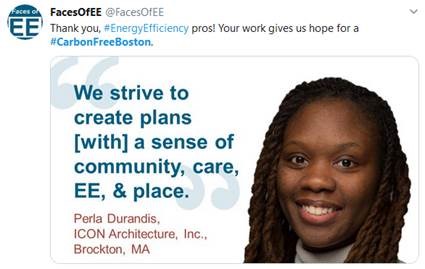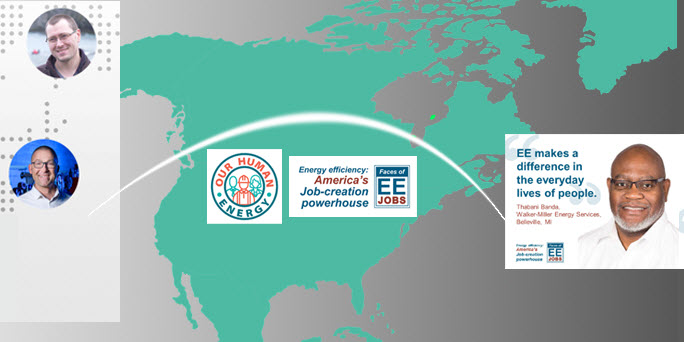by Steve Cowell
Only a few of us knew the secret at first. You’ve heard it by now though, as more and more people catch the knowledge: Energy efficiency is a solution that grows jobs and builds careers as it contributes to local economies. By local, I refer to essentially every county across the United States. Energy efficiency now supports an American workforce of more than 2.3 million people, and continues rising.
I am excited to share great news with you: Our 2019 Energy Efficiency Jobs in America is now available. It offers granular details you will find useful and valuable if you care about helping to advance clean energy, as I do.


Along with state-specific resources and statistics, the new report provides nine policy suggestions for creating hundreds of thousands of jobs for Americans in all locations. For example, we recommend investments in infrastructure such as smart meters to enable interval data analytics, and efficiency building upgrades to boost resilience. I invite you to download the visually-compelling national report summary comprising just seven concise pages.
Consider three reasons for the rise in awareness about the importance of EE jobs. They will give you a sense of why the secret is out.
1. Climate Solutions
Extreme weather, encroaching waters and health hazards are on everyone’s mind these days. How do we develop resilience? How can we keep our homes and buildings viable amidst such massive global changes that we’re witnessing and experiencing?

Cities and states are leading the way calling for increased focus and more ambitious goals to address our societal issues. Programs are being designed and readied, such as in New York and other states, and put into place. Every program and goal that requires carbon emissions reductions specifically relies on a foundation of energy efficiency to reach targets.
Stronger building codes help for new construction. And an army of retrofit workers is just scratching the surface of what’s needed for older structures. Many tens of thousands more are going to need to step up, and new businesses will be created.
2. Workforce Growth With Access and Inclusion
As new businesses emerge, workers from all geographic areas and all walks of life are required. It’s essential that minority professionals and trades-focused workers be not only included but actively recruited.


The ECA’s Knight Green Jobs Training Center prepares men and women for clean energy jobs with a bright future. (Energy Coordinating Agency, Philadelphia, PA). In nine years, ECA has provided over 5,000 entry level students, returning citizens, and building contractors with professional training.
Workforce development can be challenging, but as our report shows, opportunities are present and awaiting the people who are willing to seize the day and orient toward the energy efficiency field. Hundreds of options are available, from boots-on-the-ground to desk jobs and manufacturing jobs as well.
The call to help other people with a career that matters is alluring. So is decent pay. From software designers to sales reps, from architects to HVAC technicians, these positions run the gamut of career possibilities.
Veterans, women, returning citizens, and others can enroll in apprentice programs (and we need more of them!) and find courses to skill up and be more valuable employees. One source is the Building Performance Institute, Inc. (BPI) — our top credentialing, quality assurance, and standards-setting organization with 12,000+ Certified Professionals, 460 BPI GoldStar Contractors, and 130 Test Centers across the U.S.
Advancing workforce development is another in the set of nine recommended policies you will find in the 2019 Energy Efficiency Jobs in America.
3. The Invisible is Now Visible
The secret is out. EE workers are your neighbors, no matter where you live. Energy efficiency’s strength as a workforce and its leverage to effect positive change is now being talked about as though “everyone knows.” EE jobs often span many job sectors which leads to a lack of visibility when the larger over-arching sector is addressed. This is why we are doing this report. I hear conversations happening acknowledging the ubiquity of EE jobs. I see references to the previous jobs reports we published. With sound, robust methodology to measure EE jobs consistently year over year, we can show trends accurately.

Last year we discovered that a surprising one in six construction workers spends most of their time on energy efficiency: Construction Jobs Significant in U.S. Energy Efficiency Employment. In this year’s report, the top states for energy efficiency oriented construction jobs are again Delaware and Maryland.
The Faces of EE initiative that my team launched in 2017 collects photos and testimonials of energy efficiency workers nationwide. Faces of EE promotes the fact that “EE” means more than clean air and a stable grid; it means jobs and economic growth.
Energy Efficiency Jobs in America and the Faces of EE focus on the U.S., but our Canadian counterparts are also gaining ground with their #OurHumanEnergy campaign. North America overall is beginning to show the vital necessity of EE and pull together its voices.

The Building Performance Association (formerly the Home Performance Coalition) is also expanding its reach as we work together to advance a thriving industry delivering improved energy efficiency, health, and environmental performance of buildings. I urge you to consider becoming involved and to help spread the word.
Although compelling, the three reasons I have explored here are just a starter list, and call upon us to be attentive now more than ever before. I encourage you to spend a few minutes with Energy Efficiency Jobs in America where you will find dozens more.
One parting thought: A policy focus in the report that I appreciate is the suggestion to modernize regulation to align utilities’ incentives with energy efficiency investments and assure transparent and comprehensive cost-effectiveness evaluation. This happens to be related to one of E4TheFuture’s core objectives, valuation of resources.
My sincere thanks go to our partners BW Research Partnership and E2 for pulling together this deep analysis and co-publishing, and to my team for their hard work handling the details.
–Steve Cowell is President of E4TheFuture
